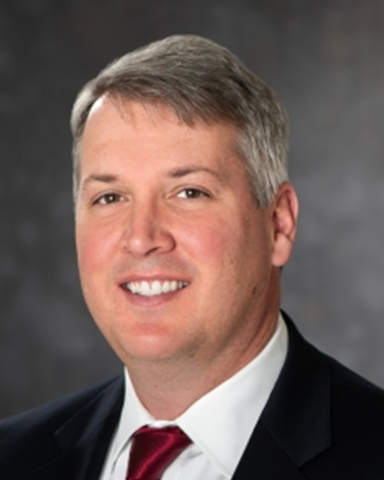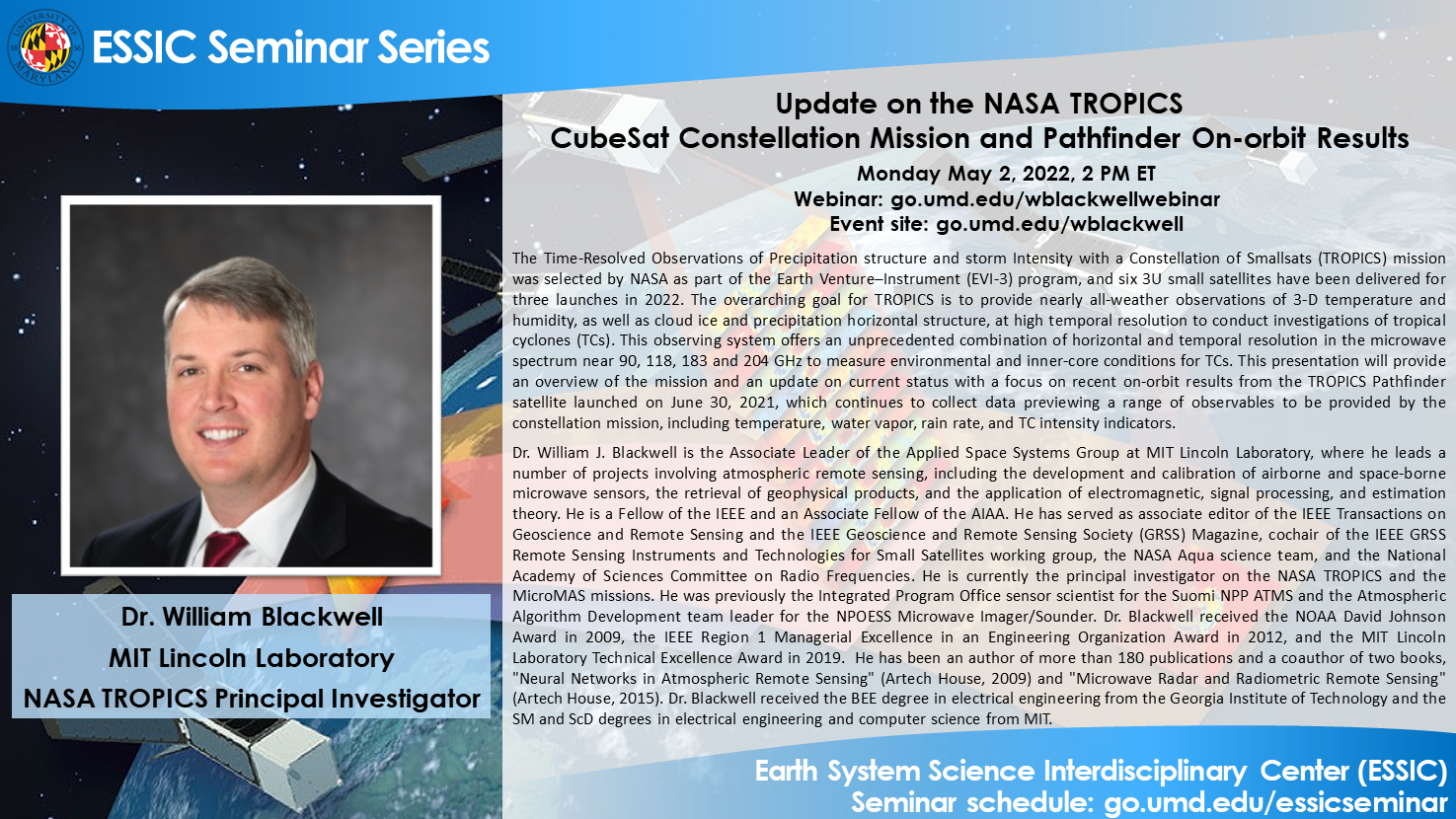
Update on the NASA TROPICS CubeSat Constellation Mission and Pathfinder On-orbit Results
This event has passed. View the seminar recording here:
Dr. William Blackwell
MIT Lincoln Laboratory
Monday May 2, 2022, 2 PM ET
Abstract:
Recent technology advances in miniature microwave radiometers that can be hosted on very small satellites have made possible a new class of constellation missions that provide very high revisit rates of tropical cyclones and other severe weather. The Time-Resolved Observations of Precipitation structure and storm Intensity with a Constellation of Smallsats (TROPICS) mission was selected by NASA as part of the Earth Venture–Instrument (EVI-3) program, and six satellites have been delivered for three launches in 2022. The overarching goal for TROPICS is to provide nearly all-weather observations of 3-D temperature and humidity, as well as cloud ice and precipitation horizontal structure, at high temporal resolution to conduct high-value science investigations of tropical cyclones (TCs), including: (1) relationships of rapidly evolving precipitation and upper cloud structures to upper-level warm-core intensity and associated storm intensity changes; (2) evolution (including diurnal variability) of precipitation structure and storm intensification in relationship to environmental humidity fields; and (3) the impact ofrapid-update observations on numerical and statistical intensity forecasts of tropical cyclones.
TROPICS will provide rapid-refresh microwave measurements (median refresh rate better than 60 minutes for the baseline mission) over the tropics that can be used to observe the thermodynamics of the troposphere and precipitation structure for storm systems at the mesoscale and synoptic scale over the entire storm lifecycle. TROPICS will comprise a constellation of six 3U CubeSats in three low-Earth orbital planes. Each CubeSat will host a high performance scanning radiometer to provide temperature profiles using seven channels near the 118.75 GHz oxygen absorption line, water vapor profiles using three channels near the 183 GHz water vapor absorption line, imagery in a single channel near 90 GHz for precipitation measurements (when combined with higher resolution water vapor channels), and a single channel at 205 GHz that is more sensitive to precipitation-sized ice particles and low-level moisture. This observing system offers an unprecedented combination of horizontal and temporal resolution in the microwave spectrum to measure environmental and inner-core conditions for TCs on a nearly global scale and is a major leap forward in the temporal resolution of several key parameters needed for assimilation into advanced data assimilation systems capable of utilizing rapid-update radiance or retrieval data.
This presentation will provide an overview of the mission and an update on current status with a focus on recent on-orbit results from the TROPICS Pathfinder satellite launched on June 30, 2021, which continues to collect data previewing a range of observables to be provided by the constellation mission, including temperature, water vapor, rain rate, and TC intensity indicators.
Biosketch:
Dr. William J. Blackwell is the Associate Leader of the Applied Space Systems Group at MIT Lincoln Laboratory, where he leads a number of projects involving atmospheric remote sensing, including the development and calibration of airborne and space-borne microwave sensors, the retrieval of geophysical products from remote radiance measurements, and the application of electromagnetic, signal processing, and estimation theory.
Dr. Blackwell has served as associate editor of the IEEE Transactions on Geoscience and Remote Sensing and the IEEE Geoscience and Remote Sensing Society (GRSS) Magazine, cochair of the IEEE GRSS Remote Sensing Instruments and Technologies for Small Satellites working group, the NASA Aqua science team, and the National Academy of Sciences Committee on Radio Frequencies. He is currently the principal investigator on the NASA TROPICS Earth Venture mission and the MicroMAS (Micro-sized Microwave Atmospheric Satellite) missions. He was previously the Integrated Program Office sensor scientist for the Advanced Technology Microwave Sounder on the Suomi National Polar Partnership launched by NOAA in 2011 and the Atmospheric Algorithm Development team leader for the National Polar-orbiting Operational Environmental Satellite System (NPOESS) Microwave Imager/Sounder.
Dr. Blackwell received the MIT Lincoln Laboratory Technical Excellence Award in 2019 for his “innovative contributions to the science and practice of environmental monitoring.” He was selected as a 2012 recipient of the IEEE Region 1 Managerial Excellence in an Engineering Organization Award “for outstanding leadership of the multidisciplinary technical team developing innovative future microwave remote sensing systems.” In 2009, he was presented with the NOAA David Johnson Award for his work in neural network geophysical parameter retrievals and microwave calibration and is coauthor of “Neural Networks in Atmospheric Remote Sensing” (Artech House, 2009) and “Microwave Radar and Radiometric Remote Sensing” (Artech House, 2015). Dr. Blackwell has also been an author of more than 180 publications related to atmospheric remote sensing. He is a Fellow of the IEEE and an Associate Fellow of the AIAA.
Dr. Blackwell received the BEE degree in electrical engineering from the Georgia Institute of Technology and the SM and ScD degrees in electrical engineering and computer science from MIT, where he was a National Science Foundation Graduate Research Fellow.
Webinar:
Webinar: https://go.umd.edu/wblackwellwebinar
Event site: https://go.umd.edu/wblackwell
Webinar number: 2621 633 6584
Webinar password: essic
To join the audio conference only:
US Toll: +1-415-655-0002
Global call-in numbers
For IT assistance:
Cazzy Medley: cazzy@umd.edu
Resources:
Seminar schedule & archive: https://go.umd.edu/essicseminar
Seminar Google calendar: https://go.umd.edu/essicseminarcalendar
Seminar recordings on Youtube: https://www.youtube.com/user/ESSICUMD

